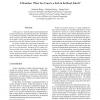Free Online Productivity Tools
i2Speak
i2Symbol
i2OCR
iTex2Img
iWeb2Print
iWeb2Shot
i2Type
iPdf2Split
iPdf2Merge
i2Bopomofo
i2Arabic
i2Style
i2Image
i2PDF
iLatex2Rtf
Sci2ools
IEEEPACT
2003
IEEE
2003
IEEE
Y-Branches: When You Come to a Fork in the Road, Take It
In this paper, we study the effects of manipulating the architected direction of conditional branches. Through the use of statistical sampling, we find that about 40% of all dynamic branches and about 50% of mispredicted branches do not affect correct program behavior when forced down the incorrect path. We call such branches Y-branches. To further examine this unexpected phenomenon, we provide a characterization of the coding constructs that give rise to such branches. Examples of such coding constructs include short-circuits and ineffectual loop iterations. We provide a statistical breakdown of the frequency of these branches and their constructs. Finally, we suggest some techniques for exploiting this behavior, particularly when it results from short-circuit constructs.
| Added | 04 Jul 2010 |
| Updated | 04 Jul 2010 |
| Type | Conference |
| Year | 2003 |
| Where | IEEEPACT |
| Authors | Nicholas J. Wang, Michael Fertig, Sanjay J. Patel |
Comments (0)

